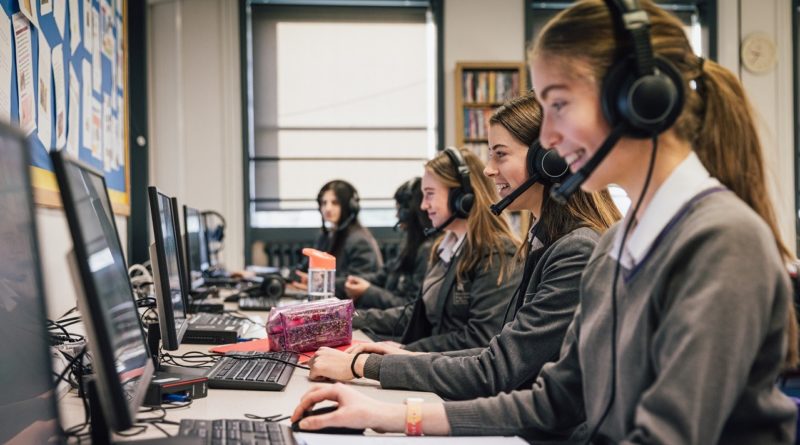Is Technology Becoming an Integral Part of Education?
Questions relating to the importance of technology in education have been posed with increasing urgency over the last fifteen months. Even before the pandemic impacted the lives of so many millions of young people, however, the so-called ‘fourth education revolution’ of artificial intelligence has been a topic that many leaders have been asked to consider.
 At the beginning of the new academic year M&D asked Helen Jeys,The Head Mistress of Manchester High School for Girls, to give her opinions on the way technology and education are connected in modern education, how the pandemic has affected the ways in which they interact with each other, and what the role of a teacher is in our times.
At the beginning of the new academic year M&D asked Helen Jeys,The Head Mistress of Manchester High School for Girls, to give her opinions on the way technology and education are connected in modern education, how the pandemic has affected the ways in which they interact with each other, and what the role of a teacher is in our times.
———————————————
In Anthony Seldon and Oladimeji Adiboye’s ‘The Fourth Education Revolution: Will Artificial Intelligence Liberate or Infantilise Humanity’, questions posed about the use of AI to revolutionise teaching make for fascinating reading. Indeed, should we always rely on the view that teaching should be the work of an individual teacher or could it be done through the process of AI; indeed, could AI liberate education?
In April 2019, the Guardian reported how ‘Beacon’, the chatbot educational tool at Staffordshire University, was enhancing the student experience by, among other things, answering timetabling questions and suggesting societies to join. Staffordshire’s vice-chancellor commented on the importance of Beacon as a tool that responded to students’ needs to have “instant access to answers.” For this university and others across the world, the aim of such AI is not to replace teachers or lecturers, but rather to enhance the student experience.
There are more ambitious projects for the use of AI, even, than this. For instance, ‘Squirrel Ai Learning’ is one of the first programmes in the world, aimed at providing personalised education for students, particularly, across China. One of the aims stated on the Squirrel AI website is to ‘strive to provide every student an AI super teacher!’ With tailored lessons for each individual student, the ability to personalise the teaching approach to individual student preferences and the ability to provide the inherent flexibility of a computer-based approach, one can see the enormous, potential benefits.
It has also been evident, during the COVID pandemic, that those who have not had access to technology have been the most affected by the interruption to learning caused by lockdowns. The so-called ‘digital divide’ had the most impact during the first lockdown of 2020 with 9% of student households not having access to tablets or computers. Thus, the most disadvantaged of students have been the most seriously impacted by the pandemic with a report by the Education Endowment Fund stating that school closures have further widened the attainment gap between disadvantaged children and their peers.
It is, therefore, clear that the pandemic has accelerated the need for technology to become an integral part of education. All students need access to technology; those students who have had free access to technology over the last fifteen months will have been the least impacted by the educational devastation caused by the pandemic. Indeed, there have been other huge advantages produced as a result of the increased use of technology in education over these recent months. Technology has enabled pupils to remain connected with their peers and with their teachers, they have been able to continue to submit work and to receive feedback, we have been able to meet with parents remotely so that we can sustain our support of our pupils. Without it, students would have suffered even more than they have already; that is in no doubt.
However, the last fifteen months has taught us something, possibly more quickly than Seldon and Adiboye might have expected in the edition of their book written in pre-pandemic times. And that is, the crucial importance of the physical teacher to the student’s experience of learning. The physical teacher might not be available 24 hours every day like a chatbot, they may not be able to personalise every teaching experience and they may not be able to provide instant feedback on every assessment completed. However, they are foundational to a student’s educational experience and to their mental health. I am sure that we all experienced how happy students were to be back to school, to see their friends and their teachers – physically again. Despite the ability our students had to sustain their education throughout the lockdown period – which was and is crucial – being back in school, being able to interact face to face with their teachers was what they needed for their emotional, educational and mental health needs.
I appreciate the immediacy that comes with technology and I also appreciate that there is an increased demand, over recent times, for us all to receive instant responses to our needs. However, learning is about more than this. Learning is about patience, perseverance, a love of scholarly endeavour which cannot be responded to instantly. An over-reliance on technology can certainly give students a false impression of what true learning is all about. Research is not instant, neither is thinking, analysis, evaluative thinking or – indeed – the ability to write at length. Furthermore, learning is collaborative and benefits from social interaction. This cannot be replicated, easily, with technology.
Let’s face it, technology is here to stay and thank goodness for that! It enhances administrative systems in schools, can reduce teacher workload and provides students with accessible information that I could only have dreamed about as a student several decades ago. It also provides tools that can enhance the learning experience. The COVID pandemic has, also, only highlighted its importance in reducing the digital divide; a term that will become part of our common parlance in the future. However, as Bill Gates himself said, “Technology is just a tool. In terms of getting the kids together and motivating them, the teacher is the most important.” The COVID pandemic has reminded that this is the case and in a way that is so timely as we look to how technology should be further implemented in schools across the world in the future. There is, in my view, no replacement for the teacher who can guide, support, motivate and inspire every student in the classroom – far more effectively than any digital replacement.








I think it would be silly for technology for not be a big part of education, as we use technology for almost everything these days x
I think it should be part of education because we use technology so much for every aspect of life, but not taking away real experiences like going out for nature walks